Using Satellite Data to Represent Tropical Instability Waves (TIWs)-Induced Wind for Ocean Modeling: A Negative Feedback onto TIW Activity in the Pacific
Abstract
:1. Introduction
2. Model and Experiment Designs
3. A No-Feedback Run (αTIW = 0.0)
4. The Effects of Tropical Instability Wave (TIW)-Induced Wind Feedback: A Reference Feedback Run
4.1. TIW-Scale Perturbations of SST and Surface Wind Stress
4.2. The Ocean-Atmosphere Coupling at TIW Scales
4.3. Relations between TIW-Scale Perturbations of Surface Atmospheric Winds and Oceanic Currents
4.4. The Eddy Kinetic Energy (EKE)
4.5. A Negative Feedback at TIW Scales
5. Discussion
5.1. The τTIW and SSTTIW Fields
5.2. TIW-Scale Coupling between the Ocean and Atmosphere
5.3. The Correlations between TIW-Induced Wind Stress (τTIW) and Oceanic Currents (VTIW)
6. Conclusion
Acknowledgments
- Conflict of InterestThe authors declare no conflict of interest.
References
- Legeckis, R. Long waves in the eastern equatorial Pacific Ocean: A view from a geostationary satellite. Science 1977, 197, 1179–1181. [Google Scholar]
- Bryden, H.L.; Brady, E.C. Eddy momentum and heat fluxes and their effects on the circulation of the equatorial Pacific Ocean. J. Mar. Res 1989, 47, 55–79. [Google Scholar]
- Wallace, J.M.; Mitchell, T.P.; Deser, C. The influence of sea surface temperature on surface wind in the eastern equatorial Pacific: Seasonal and interannual variability. J. Clim 1989, 2, 1492–1499. [Google Scholar]
- Baturin, N.; Niiler, P. Effects of instability waves in the mixed layer of the equatorial Pacific. J. Geophys. Res 1997, 102, 27771–27793. [Google Scholar]
- Qiao, L.; Weisberg, R.H. Tropical instability wave energetics: Observations from the tropical instability wave experiment. J. Phys. Oceanogr 1998, 28, 345–360. [Google Scholar]
- Masina, S.; Philander, S.G.H. An analysis of tropical instability waves in a numerical model of the Pacific Ocean. I. Spatial variability of the waves. J. Geophys. Res 1999, 104, 29613–29635. [Google Scholar]
- Kessler, W.S.; Rothstein, L.M.; Chen, D. The annual cycle of SST in the eastern tropical Pacific, diagnosed in an ocean GCM. J. Clim 1998, 11, 777–799. [Google Scholar]
- Kessler, W.S.; Kleeman, R. Rectification of the Madden–Julian Oscillation into the ENSO cycle. J. Clim 2000, 13, 3560–3575. [Google Scholar]
- Jochum, M.; Cronin, M.F.; Kessler, W.S.; Shea, D. Observed horizontal temperature advection by tropical instability waves. Geophys. Res. Lett 2007, 34, L09604. [Google Scholar]
- Jochum, M.; Deser, C.; Phillips, A. Tropical atmospheric variability forced by oceanic internal variability. J. Clim 2007, 20, 765–771. [Google Scholar]
- Chelton, D.B.; Esbensen, S.K.; Schlax, M.G.; Thum, N.; Freilich, M.H.; Wentz, F.J.; Gentemann, C.L.; McPhaden, M.J.; Schopf, P.S. Observations of coupling between surface wind stress and sea surface temperature in the eastern tropical Pacific. J. Clim 2001, 14, 1479–1498. [Google Scholar]
- Xie, S.-P. Satellite observations of cool ocean-atmosphere interaction. Bull. Amer. Meteor. Soc 2004, 85, 195–208. [Google Scholar]
- Lee, T.; Lagerloef, G.; Gierach, M.M.; Kao, H.-Y.; Yueh, S.S.; Dohan, K. Aquarius reveals salinity structure of tropical instability waves. Geophys. Res. Lett 2012, 39, L12610. [Google Scholar]
- Wentz, F.J.; Gentemann, C.; Smith, D.; Chelton, D. Satellite measurements of sea surface temperature through clouds. Science 2000, 288, 847–850. [Google Scholar]
- Kravtsov, S.; Kondrashov, D.; Kamenkovich, I.; Ghil, M. An empirical stochastic model of sea-surface temperatures and surface winds over the Southern Ocean. Ocean Sci 2012, 7, 755–770. [Google Scholar]
- Liu, W.T.; Xie, X.; Polito, P.S.; Xie, S.-P.; Hashizume, H. Atmospheric manifestation of tropical instability waves observed by QuikSCAT and Tropical Rain Measuring Mission. Geophys. Res. Lett 2000, 27, 2545–2548. [Google Scholar]
- Chelton, D.B.; Schlax, M.G.; Freilich, M.H.; Milliff, R.F. Satellite measurements reveal persistent small-scale features in ocean winds. Science 2004, 303, 978–983. [Google Scholar]
- Hashizume, H.; Xie, S.-P.; Liu, W.T.; Takeuchi, K. Local and remote atmospheric response to tropical instability waves: A global view from the space. J. Geophys. Res 2001, 106, 10173–10185. [Google Scholar]
- Zhang, R.-H.; Busalacchi, A.J. An empirical model for surface wind stress response to SST forcing induced by tropical instability waves (TIWs) in the eastern equatorial Pacific. Mon. Wea. Rev 2009, 137, 2021–2046. [Google Scholar]
- Zhang, R.-H. Effects of tropical instability wave (TIW)-induced surface wind feedback. Clim. Dyn. 2013, in press.. [Google Scholar]
- Seo, H.; Jochum, M.; Murtugudde, R.; Miller, A.J.; Roads, J.O. Feedback of tropical instability-wave-induced atmospheric variability onto the ocean. J. Clim 2007, 20, 5842–5855. [Google Scholar]
- Pezzi, L.P.; Vialard, J.; Richards, K.J.; Menkes, C.; Anderson, D. Influence of ocean-atmosphere coupling on the properties of tropical instability waves. Geophys. Res. Lett 2004, 31, L16306. [Google Scholar]
- Small, R.J.; Richards, K.J.; Xie, S.-P.; Dutrieux, P.; Miyama, T. Damping of tropical instability waves caused by the action of surface currents on stress. J. Geophys. Res 2009, 114, C04009. [Google Scholar]
- Lien, R.-C.; D’Asaro, E.A.; Menkes, C.E. Modulation of equatorial turbulence by tropical instability waves. Geophys. Res. Lett 2008, 35, L24607. [Google Scholar]
- Moum, J.N.; Lien, R.-C.; Perlin, A.; Nash, J.D.; Gregg, M.C.; Wiles, P.J. Sea surface cooling at the Equator by subsurface mixing in tropical instability waves. Nat. Geosci 2009, 2, 761–765. [Google Scholar]
- Contreras, R.F. Long-term observations of tropical instability waves. J. Phys. Oceanogr 2002, 32, 2715–2722. [Google Scholar]
- Xie, S.-P.; Miyama, T.; Wang, Y.; Xu, H.; de Szoeke, S.P.; Small, R.J.; Richards, K.J.; Mochizuki, T.; Awaji, T. A regional ocean–atmosphere model for eastern Pacific climate: Toward reducing Tropical biases. J. Clim 2006, 20, 1504–1522. [Google Scholar]
- Roberts, M.J.; Clayton, A.; Demory, M.-E.; Donners, J.; Vidale, P. L.; Norton, W.; Shaffrey, L.; Stevens, D.P.; Stevens, I.; Wood, R.A.; et al. Impact of resolution on the tropical Pacific circulation in a matrix of coupled models. J. Clim 2009, 22, 2541–2556. [Google Scholar]
- Shaffrey, L.C.; Stevens, I.; Norton, W.A.; Roberts, M.J.; Vidale, P.L.; Harle, J.D.; Jrrar, A.; Stevens, D.P.; Woodage, M.J.; Demory, M.E.; et al. UK HiGEM: The new UK high-resolution global environment model—Model description and basic evaluation. J. Clim 2009, 22, 1861–1896. [Google Scholar]
- Zhang, R.-H.; Busalacchi, A.J. Rectified effects of tropical instability wave (TIW)-induced atmospheric wind feedback in the tropical Pacific. Geophys. Res. Lett 2008, 35, L05608. [Google Scholar]
- Gent, P.; Cane, M.A. A reduced gravity, primitive equation model of the upper equatorial ocean. J. Comp. Phys 1989, 81, 444–480. [Google Scholar]
- Chen, D.; Rothstein, L.M.; Busalacchi, A.J. A hybrid vertical mixing scheme and its application to tropical ocean models. J. Phys. Oceanogr 1994, 24, 2156–2179. [Google Scholar]
- Murtugudde, R.; Seager, R.; Busalacchi, A.J. Simulation of tropical oceans with an ocean GCM coupled to an atmospheric mixed layer model. J. Clim 1996, 9, 1795–1815. [Google Scholar]
- Murtugudde, R.; Beauchamp, J.; McClain, C.R.; Lewis, M.; Busalacchi, A.J. Effects of penetrative radiation on the upper tropical ocean circulation. J. Clim 2002, 15, 470–486. [Google Scholar]
- Zhang, R.-H.; Busalacchi, A.J.; Murtugudde, R.G. Improving SST anomaly simulations in a layer ocean model with an embedded entrainment temperature submodel. J. Clim 2006, 19, 4638–4663. [Google Scholar]
- Zhang, R.-H.; Busalacchi, A.J.; Wang, X.; Ballabrera-Poy, J.; Murtugudde, R.G.; Hackert, E.C.; Chen, D. Role of ocean biology-induced climate feedback in the modulation of El Niño-Southern Oscillation. Geophys. Res. Lett 2009, 36, L03608. [Google Scholar]
- Zhang, R.-H.; Zheng, F.; Zhu, J.; Pei, Y.; Zheng, Q.; Wang, Z. Modulation of El Niño-southern oscillation by freshwater flux and salinity variability in the tropical Pacific. Adv. Atmos. Sci 2012, 29, 647–660. [Google Scholar]
- O’Neill, L.W.; Chelton, D.B.; Esbensen, S.K. The effects of SST-induced surface wind speed and direction gradients on midlatitude surface vorticity and divergence. J. Clim 2010, 23, 255–281. [Google Scholar]
- Chelton, D.B. The impact of SST specification on ECMWF surface wind stress fields in the eastern tropical Pacific. J. Clim 2005, 18, 530–550. [Google Scholar]
- Zhang, R.-H.; Levitus, S. Interannual variability of the coupled Tropical Pacific ocean-atmosphere system associated with the El Nino/Southern Oscillation. J. Clim 1997, 10, 1312–1330. [Google Scholar]
- Zhang, R.-H.; Zheng, F.; Zhu, J.; Wang, Z.G. A successful real-time forecast of the 2010–11 La Niña event. Sci. Rep. 2013. [Google Scholar] [CrossRef]
- Zhang, R.-H.; Busalacchi, A.J.; Murtugudde, R.G.; Hackert, E.C.; Ballabrera-Poy, J. A new approach to improved SST anomaly simulations using altimeter data: Parameterizing entrainment temperature from sea level. Geophys. Res. Lett 2004, 31, L10304. [Google Scholar]
- Zhang, R.-H.; Chen, D.; Wang, G. Using satellite ocean color data to derive an empirical model for the penetration depth of solar radiation (Hp) in the tropical Pacific ocean. J. Atmos. Ocean. Technol 2011, 28, 944–965. [Google Scholar]
- Zhang, R.-H.; Pei, Y.; Chen, D. Remote effects of tropical cyclone (TC) wind forcing over the western Pacific on the eastern equatorial ocean. Adv. Atmos. Sci. 2013, in press.. [Google Scholar]
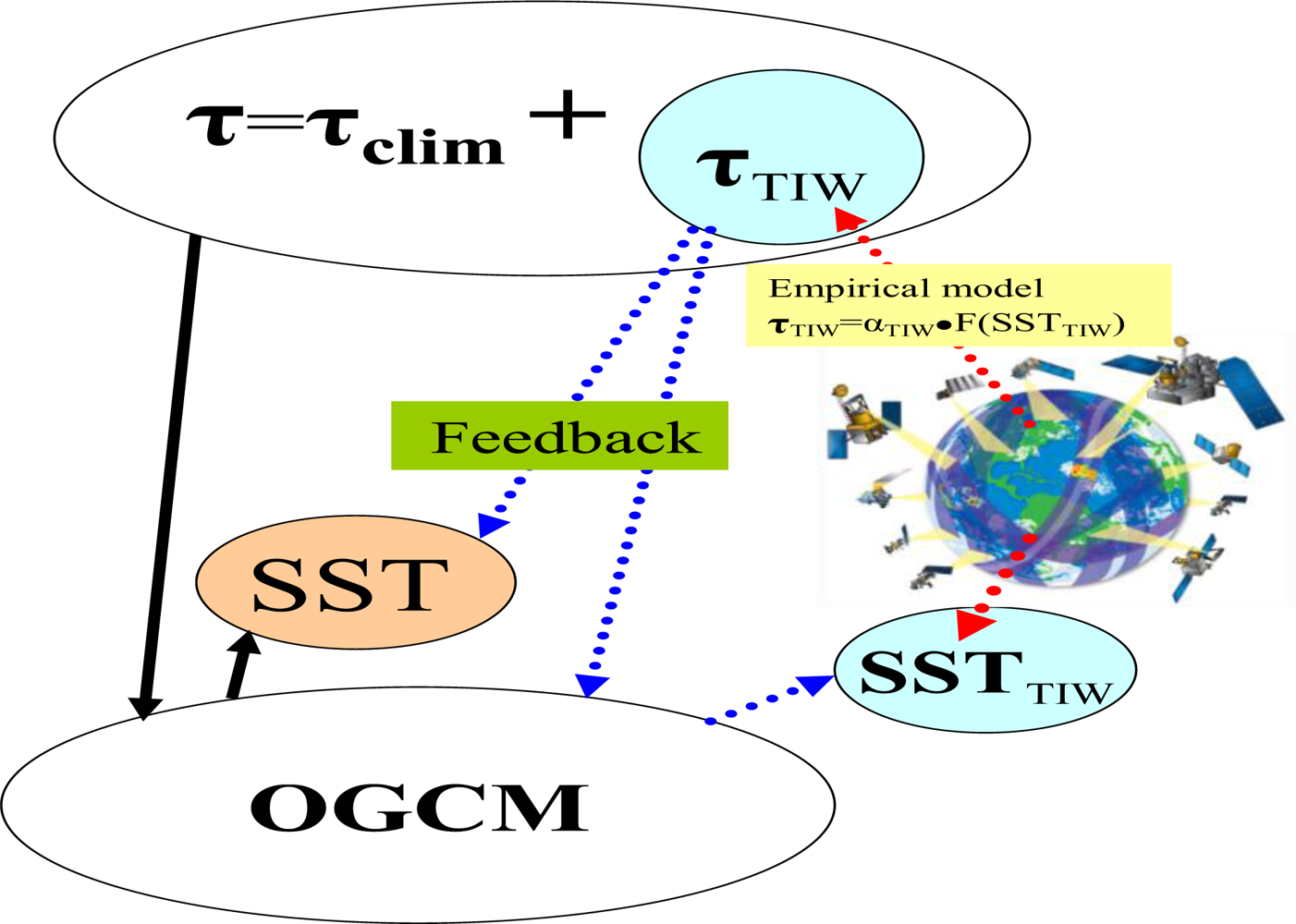


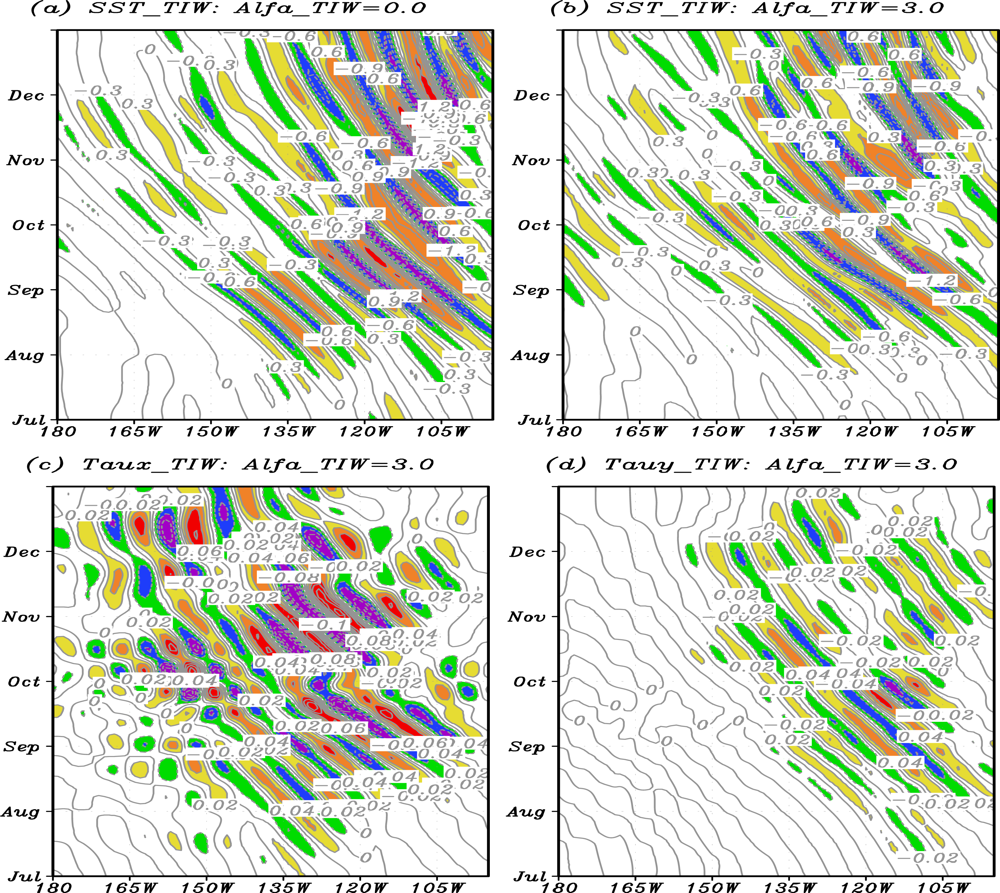
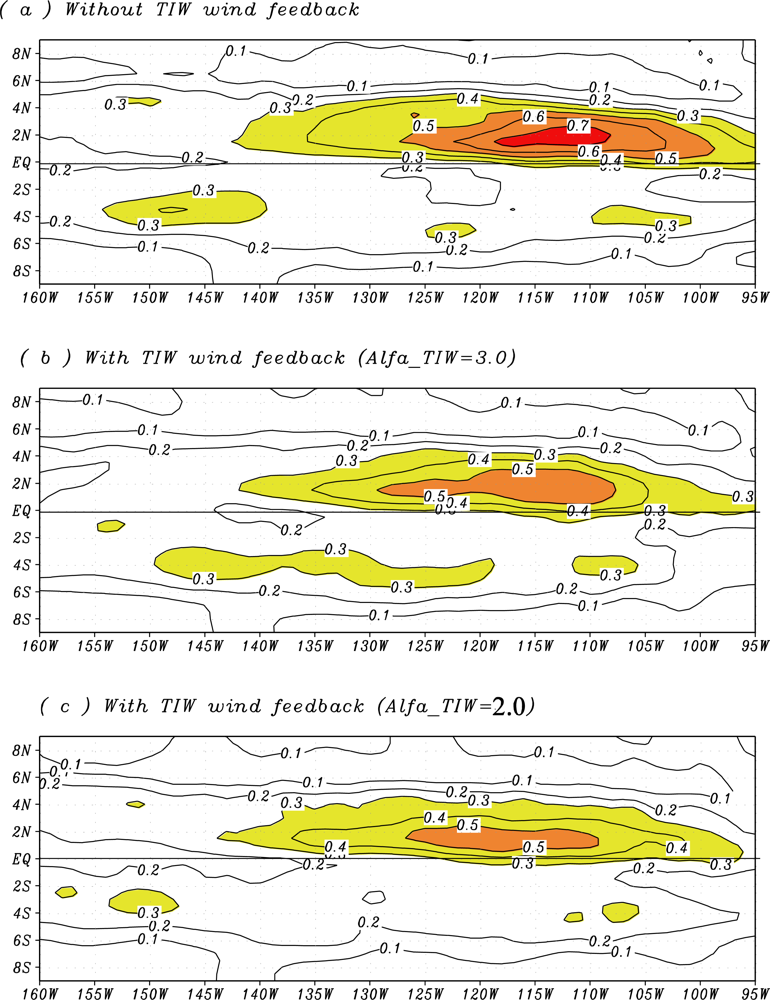
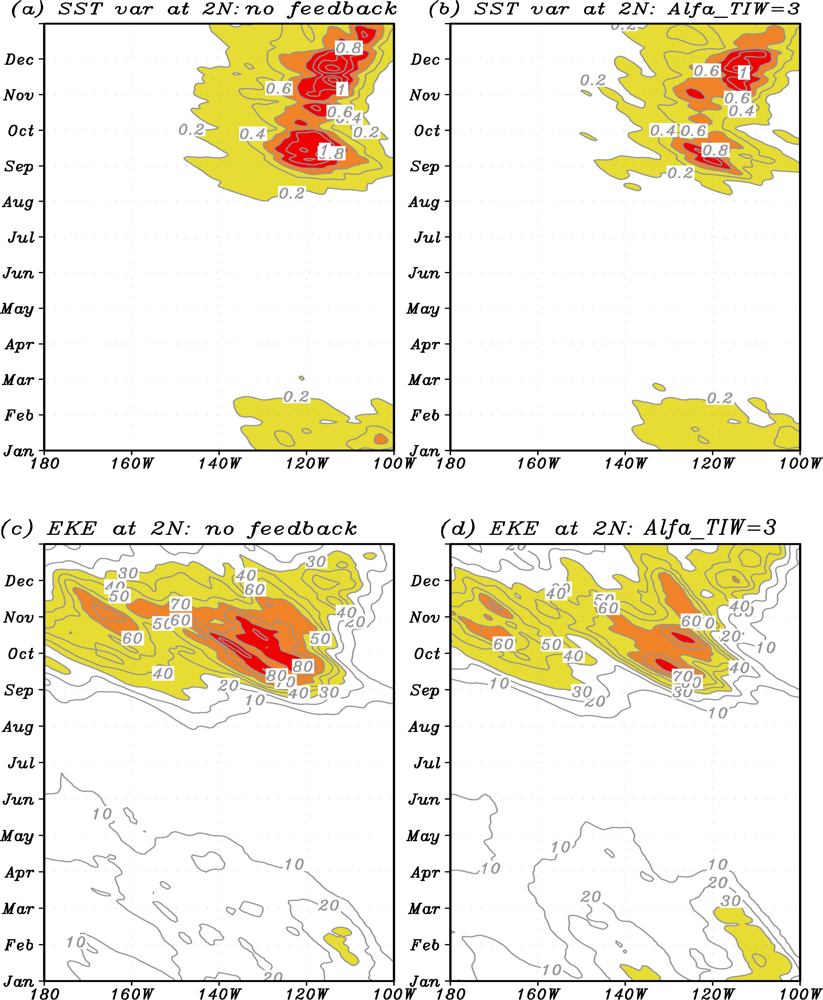
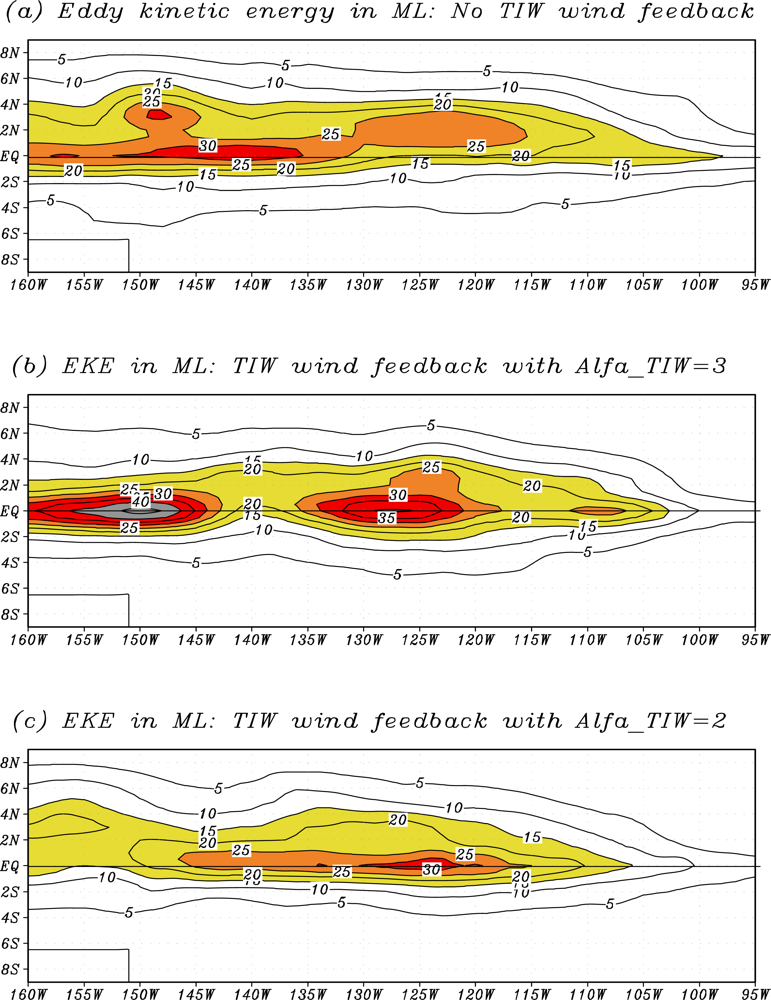


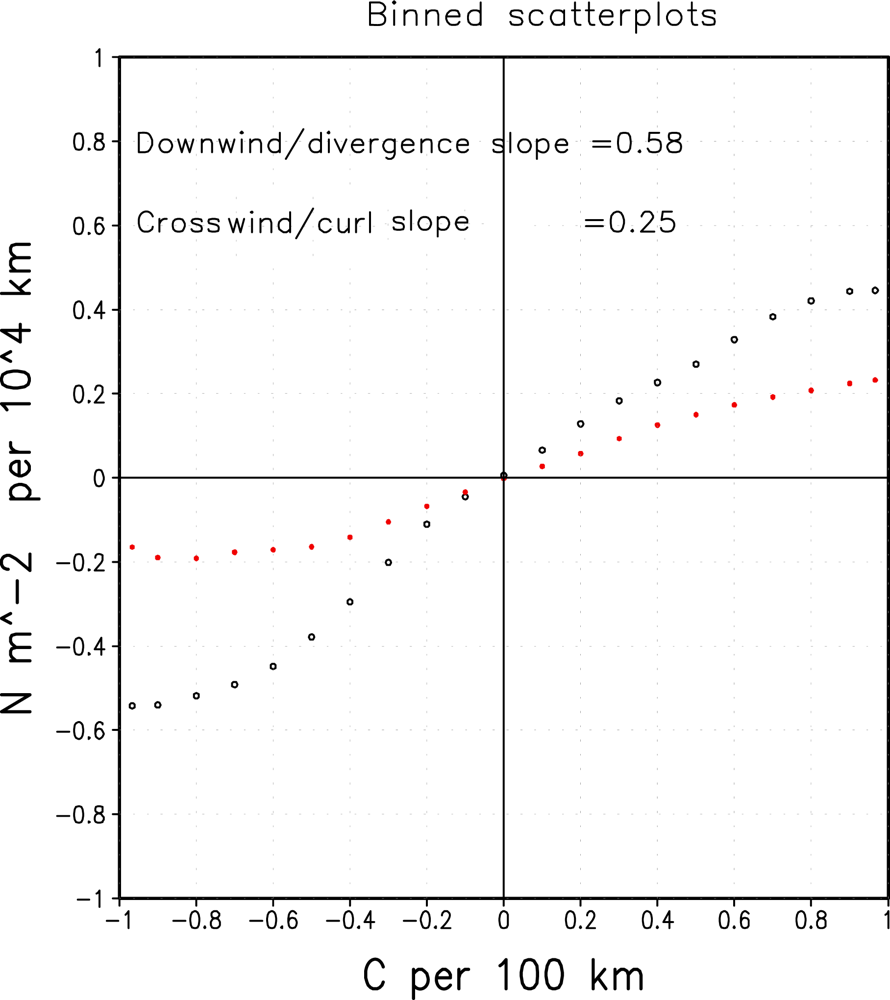

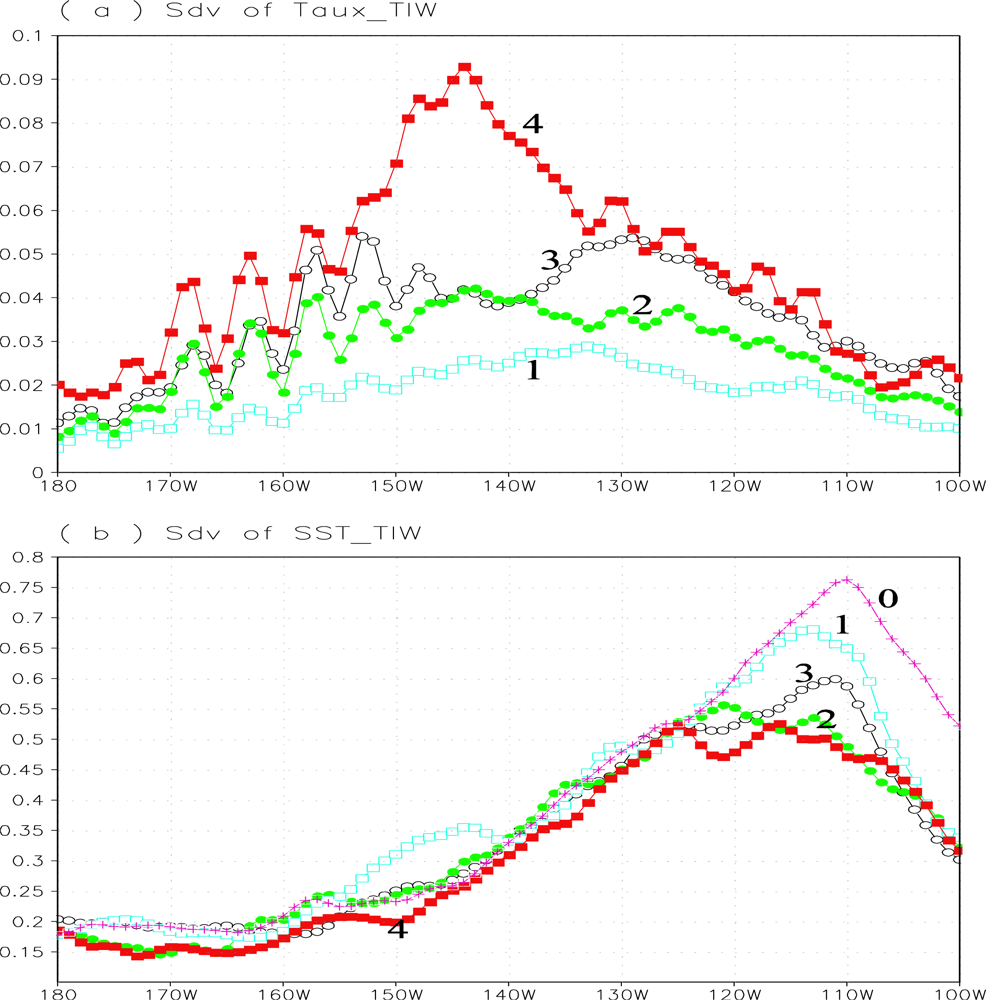


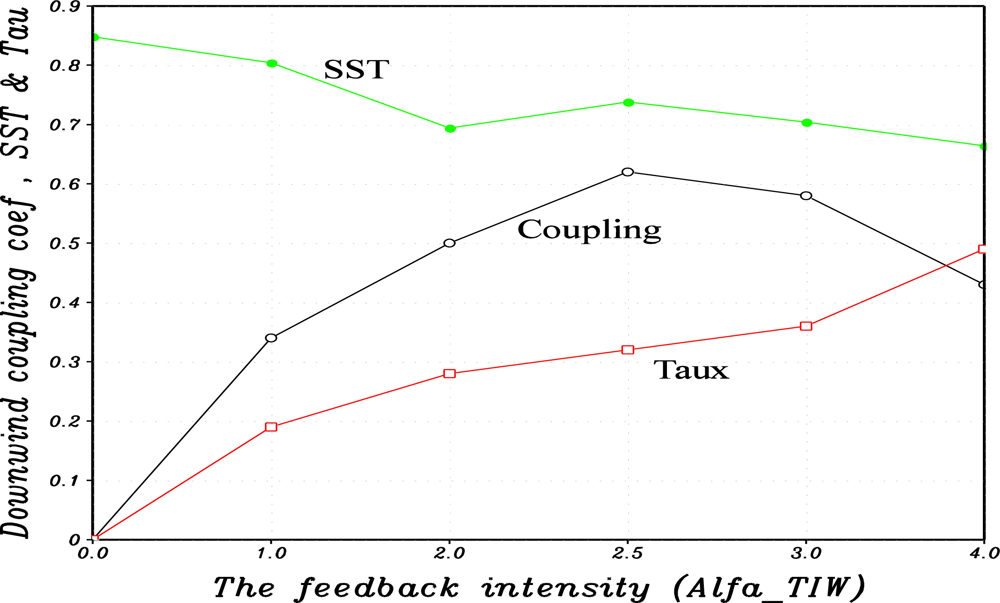
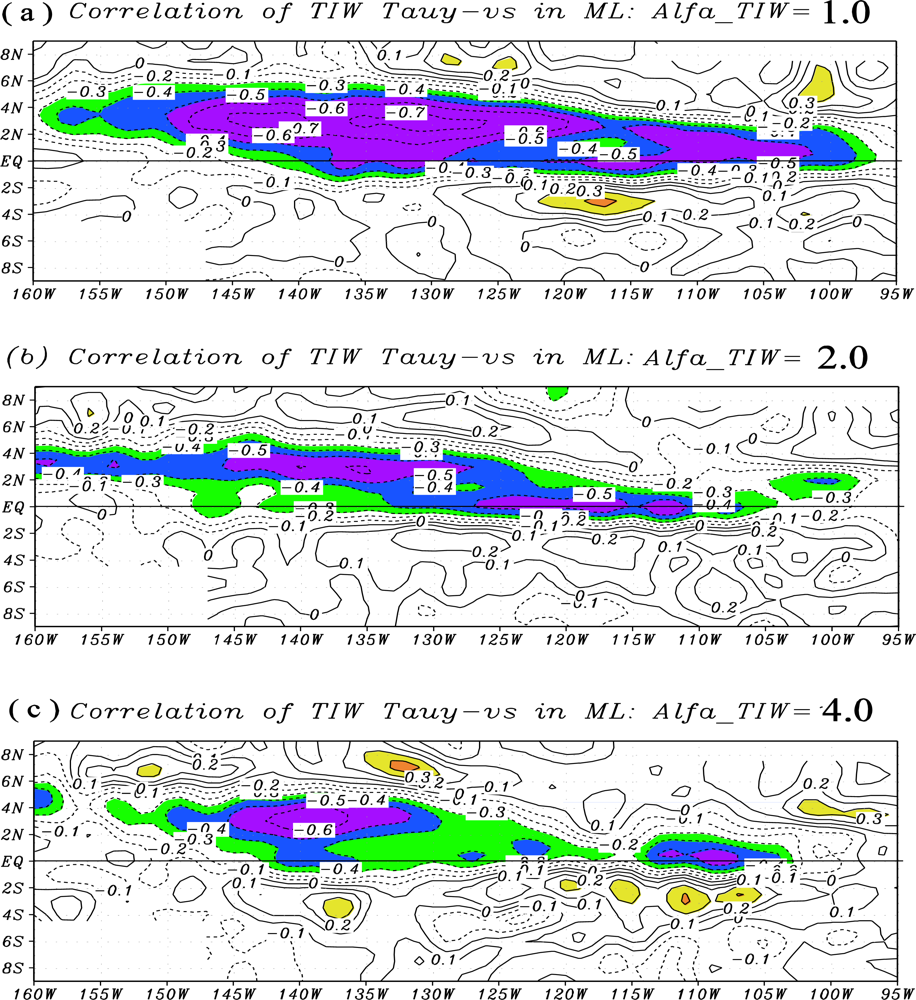
| αTIW | Sdv of τTIW | Sdv of SSTTIW | Downwind Coupling Coef | Corsswind Coupling Coef |
|---|---|---|---|---|
| 0.0 | 0.0 | 0.424 | 0.0 | 0.0 |
| 1.0 | 0.019 | 0.402 | 0.34 | 0.14 |
| 2.0 | 0.028 | 0.347 | 0.50 | 0.22 |
| 2.5 | 0.032 | 0.369 | 0.62 | 0.24 |
| 3.0 | 0.036 | 0.352 | 0.58 | 0.25 |
| 4.0 | 0.049 | 0.332 | 0.43 | 0.17 |
© 2013 by the authors; licensee MDPI, Basel, Switzerland This article is an open access article distributed under the terms and conditions of the Creative Commons Attribution license (http://creativecommons.org/licenses/by/3.0/).
Share and Cite
Zhang, R.-H.; Li, Z.; Min, J. Using Satellite Data to Represent Tropical Instability Waves (TIWs)-Induced Wind for Ocean Modeling: A Negative Feedback onto TIW Activity in the Pacific. Remote Sens. 2013, 5, 2660-2687. https://doi.org/10.3390/rs5062660
Zhang R-H, Li Z, Min J. Using Satellite Data to Represent Tropical Instability Waves (TIWs)-Induced Wind for Ocean Modeling: A Negative Feedback onto TIW Activity in the Pacific. Remote Sensing. 2013; 5(6):2660-2687. https://doi.org/10.3390/rs5062660
Chicago/Turabian StyleZhang, Rong-Hua, Zhongxian Li, and Jinzhong Min. 2013. "Using Satellite Data to Represent Tropical Instability Waves (TIWs)-Induced Wind for Ocean Modeling: A Negative Feedback onto TIW Activity in the Pacific" Remote Sensing 5, no. 6: 2660-2687. https://doi.org/10.3390/rs5062660




